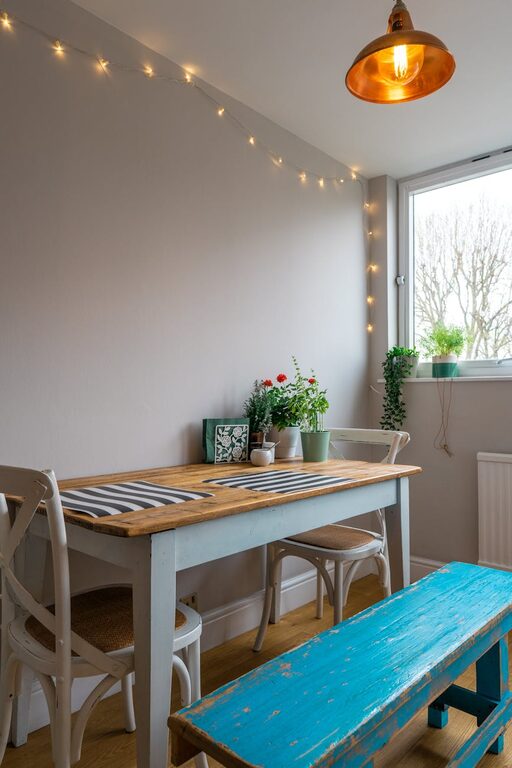
When a room feels dark and gloomy, it can affect the mood and energy of the entire home. Fortunately, brightening a dark space doesn’t have to mean major renovations or expensive lighting installations. With a few quick ideas and thoughtful choices, you can transform any dim room into a welcoming, light-filled area. In this post, we’ll explore practical tips to boost natural light, enhance artificial lighting, and use color and decor to create a brighter atmosphere.
Assessing the Room’s Natural Light
Before adding lamps or changing colors, take a moment to observe how light enters your room throughout the day. Understanding the room’s natural lighting pattern helps you choose the best strategies to amplify it.
– Windows: Are the windows small or obstructed by trees or curtains?
– Direction: Which direction does the window face? South-facing windows get bright, warm light, while north-facing ones receive cooler, softer light.
– Obstructions: Are there heavy drapes, blinds, or large furniture blocking light?
Once you identify these factors, you can take steps to maximize the light you already have.
Maximize Natural Light
Keep Windows Clean and Clear
Dirt and dust can block sunlight from entering your home. Regularly clean windows inside and out to make sure light comes in unobstructed.
Use Sheer Curtains or Light Fabrics
Heavy curtains block much of the sun’s rays. Swap them for sheer, translucent curtains that allow light to filter through gently while maintaining privacy.
Remove Window Obstructions
– Trim outdoor plants or bushes near windows.
– Move furniture that sits in front of windows.
Add Mirrors Strategically
Mirrors reflect and amplify natural light, making the room feel larger and brighter. Place a large mirror opposite or adjacent to a window to bounce light around the space.
Enhance Artificial Lighting
In rooms that lack sufficient daylight, layering your artificial lighting is key to creating brightness and depth.
Use Multiple Light Sources
Think beyond one overhead fixture. Combine ambient, task, and accent lighting, such as:
– Ceiling lights or chandeliers
– Table lamps
– Floor lamps
– Wall sconces
– LED strip lights or under-cabinet lights in kitchens
Choose Bright, Warm LED Bulbs
LED bulbs use less energy and last longer. For a cozy yet bright feel, pick bulbs with a color temperature around 2700K to 3000K. Avoid bulbs that emit dim or cold light unless you want a specific mood.
Add Reflective Surfaces
Light-colored or glossy lampshades and fixtures can help distribute light better. Consider lamps with metallic finishes or glass elements to reflect brightness.
Use Color to Brighten the Space
Color has a stunning impact on how bright or dark a room feels. Lighter hues make a space feel open and airy.
Paint Walls and Ceilings Light Colors
– Whites, creams, soft pastels, and light grays are great options.
– For ceilings, a bright white paint will reflect more light downward.
Choose Light-Colored Furniture and Decor
Dark furniture can soak up light. Try choosing chairs, couches, rugs, and accessories in lighter shades or with reflective accents.
Incorporate Color Through Textiles
Use throw pillows, curtains, and bedding in fresh, bright colors or subtle patterns that uplift the room’s look.
Smart Furniture Arrangement and Decor Tips
Keep It Minimal and Uncluttered
Clutter can make a room feel cramped and darker. Minimal furniture and tidy spaces let light flow freely.
Use Furniture With Legs
Furniture that lifts off the floor creates more visible floor space and lets light travel under and around pieces better.
Opt for Glass or Lucite Pieces
Clear tables, stools, or shelves add utility without blocking light or sightlines in a room.
Add Plants
Besides bringing life, plants with bright green leaves reflect light and add color. Choose plants that thrive in low light if natural sunshine is limited.
Additional Tricks to Boost Brightness
– Use light-colored rugs: They can brighten dark floors and add softness.
– Add metallic or mirrored decor: Objects like picture frames, vases, and trays can catch and reflect light.
– Keep doors open: Open internal doors to let light flow from brighter areas of the home.
Final Thoughts
Brightening a dark room doesn’t have to be complicated. By combining small changes—like swapping curtains, rearranging furniture, and layering light sources—you can make a stunning difference without spending a lot of time or money. Experiment with these quick ideas and watch your space become lighter and more inviting.
Feel free to try these tips one by one or combine several for best results. With a little effort, your dark room can soon feel like the brightest spot in your home!
